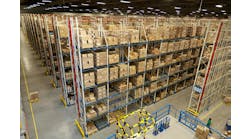“While the Administration supports the underlying intent of H.R. 1, the Administration has serious concerns with several of the bill’s provisions and cannot support House passage of the bill in its current form,” said a Statement of Administration policy issued by the White House shortly after the U.S. House of Representatives proposed and passed H.R. 1, “Implementing the 9/11 Commission Recommendations Act of 2007.” The bill, which was passed without going through the committee process, would require 100% inspection of air cargo on passenger aircraft and scanning of all ocean containers bound for U.S. ports.
Specifically, H.R. 1 would phase in inspection of air cargo carried on passenger aircraft on a schedule requiring 35% of cargo to be inspected by the end of fiscal 2007, 65% to be inspected by the end of fiscal 2008 and 100% inspection by the end of fiscal 2009.
Ocean containers would have to be scanned and secured with a “smart seal” under the provisions of H.R. 1. Within three years of the Act becoming law, 100% of containers from countries that shipped more than 75,000 twenty-foot-equivalent units (TEUs) to the United States in 2005 would have to meet the requirements. Within five years, all origins would have to comply.
The Retail Industry Leaders Association (RILA) echoes the Bush Administration’s sentiments that the provisions of the Safe Port Act passed in 2006 be implemented and allowed to operate before considering further measures. RILA pointed out its members were among the first to join in the voluntary Customs-Trade Partnership Against Terrorism (C-TPAT) and other initiatives such as the Security Freight Initiative and they have actively worked to test and pilot various security technologies at some of the world’s busiest ports.
The 9/11 Commission did not recommend 100% scanning of U.S.-bound cargo, said the RILA. Instead, it recommended a risk-based approach. The White House statement also voiced support for the risk-based approach and said it had worked to build a “layered defense.”
“The Administration has invested heavily in managing the risk associated with the approximately ten million cargo containers that enter our seaports each year, and enhanced targeting and risk management will continue to be a key priority,” said the White House statement. The White House also pointed out that efforts in 50 overseas ports to inspect high-risk containers already cover more than 80% of maritime containerized cargo “shipped to the homeland.”
“The Administration strongly opposes the bill’s requirement to scan, within five years, 100 percent of all U.S.-bound containers prior to loading at overseas ports. Such a requirement is neither executable nor feasible. Nevertheless, the Administration understands the need for a cooperative international approach to container scanning and is working diligently with its international trading partners to test the concept of operations to scan 100 percent of the containers in three foreign ports as part of the implementation of the SAFE Port Act enacted just last fall.”
It isn’t clear yet whether it would be effective or would negatively impact trade flows if extended to over 700 ports worldwide that ship to the US, said the White House.
“Imposing such requirements ignores two crucial facts. First, the United States cannot force foreign ports to provide 100 percent scanning. Second, the United States needs to be able to determine, for security-related and other reasons, that such scanning operations are not appropriate at a particular foreign port,” said the Bush statement.
On the subject of air cargo inspections, the Airforwarders Association said H.R. 1 requires technology that doesn’t exist, explaining, the technology doesn’t exist to inspect all air cargo without disrupting the legitimate flow of commerce. The Bush Administration pointed out, “Imposition of this requirement would likely result in the shifting of all cargo shipping away from passenger airlines; a step that we should consider taking only if the layered defenses put in place are not working—a premise with which we disagree.”


